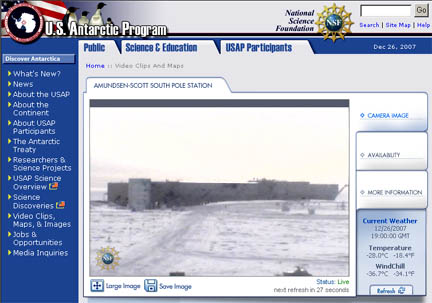Arts Journal
Aesthetic Grounds
December 2007, Archives
Antarctic Artists & Writer’s Program
The Antarctic Artists & Writers Program provides opportunities for scholars in the humanities (painting, photography, writing, history, and other liberal arts) to work in Antarctica and the Southern Ocean. These visitors will be able to make observations at U.S. Antarctic Program stations and research camps and in wilderness areas. The purpose is to enable serious writings and the arts that increase understanding of the Antarctic and help document America’s Antarctic heritage.
The skills of the visual artists range contemporary intellectuals to mediocre landscape painters and photographers. Below are a few interesting ones. (See 2007 Exhibition at the End of the World for other icy works.)
 Werner Herzog making his recent film
Werner Herzog making his recent film
“ENCOUNTERS AT THE END OF THE WORLD, a documentary film based on the Herzog’s perception that the continent’s volcanic activity, geological history, evolution and survival of life, represents the inner landscape of our planet. The project will culminate in a feature length film with support from Creative Differences Productions, and the Discovery Channel and will also be distributed on DVD.” Sept 10, 2007 was the Official Premiere in Tronto. Not yet available on Netflix.
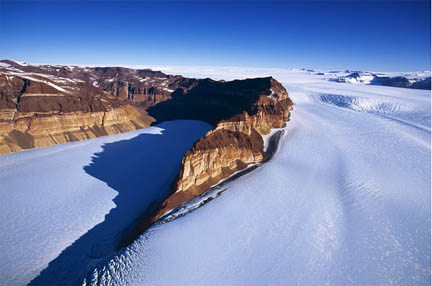 ‘Yann Arthus-Bertrand. Earth from Above Project.
‘Yann Arthus-Bertrand. Earth from Above Project.
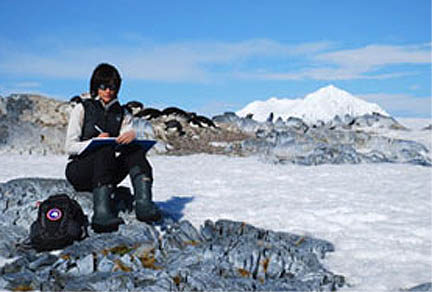 Kim Baranowki writes in her journal
Kim Baranowki writes in her journal
“Sculptor and gallery installation artist, Kimberly Baranowski’s travled to Palmer Station, Antarctica to gather research for her project, The Frozen Field. Her work will be comprised of a series of Antarctic-inspired, large sculptural installations that seek to instill a sense of wonder at the beauty of the region, while bringing to light the potential for instability in the Antarctic Peninsula ecosystem”
 Andrea Polli’s research results in 1000+ Flickr photos
Andrea Polli’s research results in 1000+ Flickr photos
“Andrea Polli, a digital media artist living and working in New York, specializes in the interpretation and presentation of weather and climate data using sound. Her work is part of a growing interdisciplinary movement in what is called data sonification. Like its counterpart, data visualization, sonification transforms data to communicate meaning.”
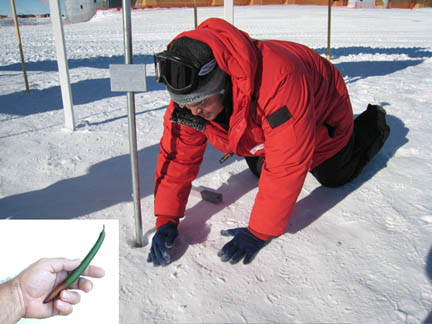 Cortada buries a Mangrove seeding for a 150,000 year journey to the coast
Cortada buries a Mangrove seeding for a 150,000 year journey to the coast
“Miami artist Xavier Cortada planted a replica of a mangrove seedling in the South Pole.* The mangrove “seedling” was be planted on the 3 km thick glacial ice sheet that blankets the South Pole.
Embedded in the moving glacier, the “seedling” is now begin sliding downhill (9.9 meters every year) in the direction of the Weddell Sea, 1,400 km away. The “seedling” has thus begun its 150,000 year journey towards the seashore, where it can eventually (theoretically) set its roots.”
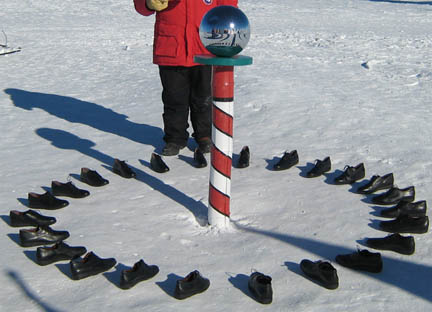 Cortada installation around the official South Pole ceremonial marker.
Cortada installation around the official South Pole ceremonial marker.
I could not discover the designer of the ceremonial pole, but it appears designed by Santa’s elves. According to the National Science Foundation, on January 1 of every year, a new brass marker is placed at 90 degrees South to designate the location of the Geographic South Pole. The ice sheet where the South Pole is located moves approximately seven meters a year. Previous years’ markers are left standing for a few years, illustrating the movement of the ice sheet. Participants wintering at the South Pole design and create the unique markers each year.
